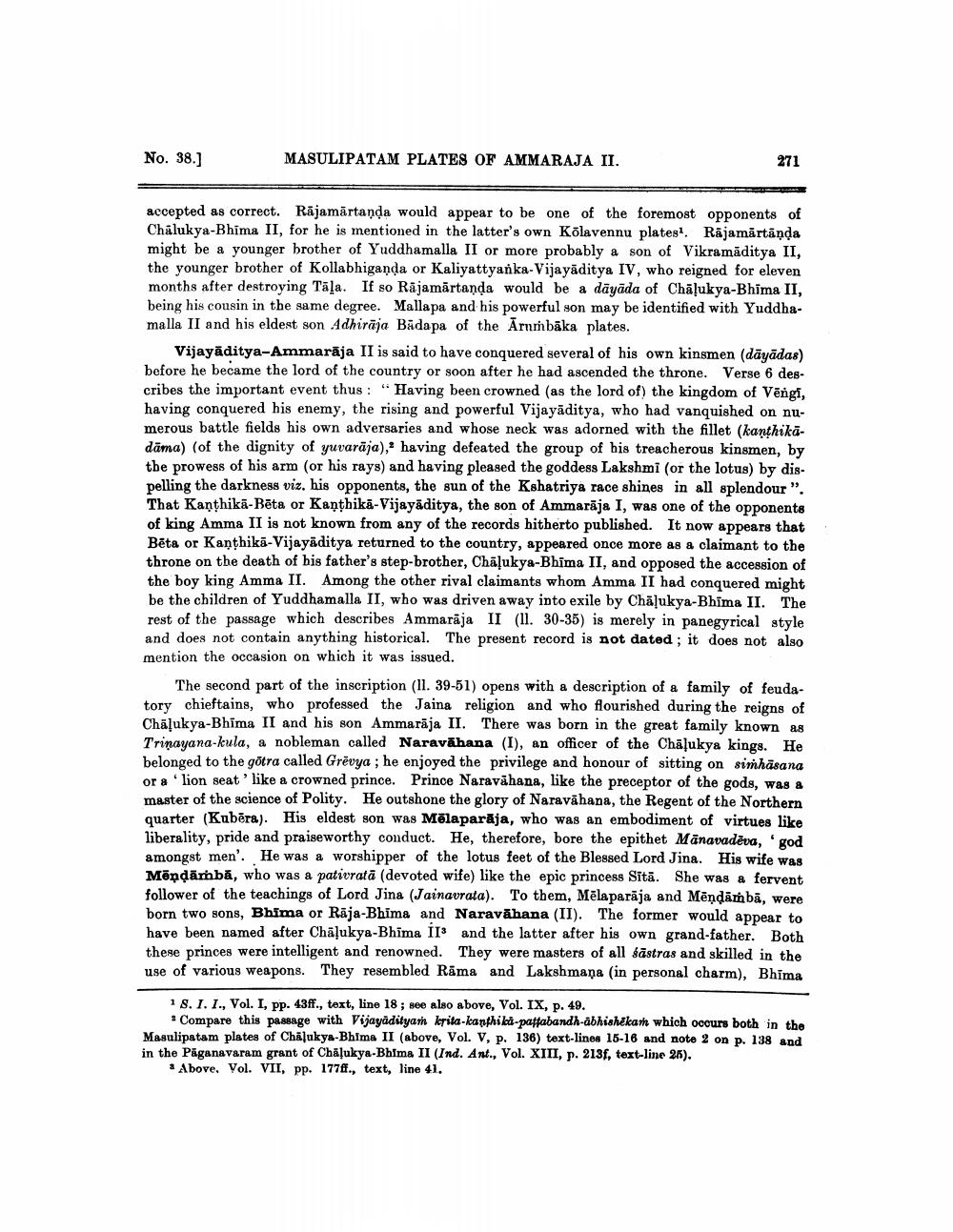________________
No. 38.]
MASULIPATAM PLATES OF AMMARAJA II.
271
accepted as correct. Rajamärtanda would appear to be one of the foremost opponents of Chalukya-Bhima II, for he is mentioned in the latter's own Kõlavennu plates1. Rājamārtāṇḍa might be a younger brother of Yuddhamalla II or more probably a son of Vikramaditya II, the younger brother of Kollabhiganda or Kaliyattyanka-Vijayaditya IV, who reigned for eleven months after destroying Tala. If so Rājamārtaṇḍa would be a dayāda of Chalukya-Bhima II, being his cousin in the same degree. Mallapa and his powerful son may be identified with Yuddhamalla II and his eldest son Adhiraja Badapa of the Arumbāka plates.
Vijayaditya-Ammarāja II is said to have conquered several of his own kinsmen (dāyādas) before he became the lord of the country or soon after he had ascended the throne. Verse 6 describes the important event thus: "Having been crowned (as the lord of) the kingdom of Vēngi, having conquered his enemy, the rising and powerful Vijayaditya, who had vanquished on numerous battle fields his own adversaries and whose neck was adorned with the fillet (kanthikadama) (of the dignity of yuvaraja), having defeated the group of his treacherous kinsmen, by the prowess of his arm (or his rays) and having pleased the goddess Lakshmi (or the lotus) by dispelling the darkness viz. his opponents, the sun of the Kshatriya race shines in all splendour ". That Kanthika-Bēta or Kanthika-Vijayaditya, the son of Ammaraja I, was one of the opponents of king Amma II is not known from any of the records hitherto published. It now appears that Bēta or Kanthika-Vijayaditya returned to the country, appeared once more as a claimant to the throne on the death of his father's step-brother, Chalukya-Bhima II, and opposed the accession of the boy king Amma II. Among the other rival claimants whom Amma II had conquered might be the children of Yuddhamalla II, who was driven away into exile by Chalukya-Bhima II. The rest of the passage which describes Ammarāja II (11. 30-35) is merely in panegyrical style and does not contain anything historical. The present record is not dated; it does not also mention the occasion on which it was issued.
The second part of the inscription (11. 39-51) opens with a description of a family of feudatory chieftains, who professed the Jaina religion and who flourished during the reigns of Chāļukya-Bhima II and his son Ammarāja II. There was born in the great family known as Trinayana-kula, a nobleman called Naravahana (I), an officer of the Chalukya kings. He belonged to the gōtra called Grēvya; he enjoyed the privilege and honour of sitting on simhasana or a lion seat' like a crowned prince. Prince Naravahana, like the preceptor of the gods, was a master of the science of Polity. He outshone the glory of Naravahana, the Regent of the Northern quarter (Kubera). His eldest son was Mēlaparāja, who was an embodiment of virtues like liberality, pride and praiseworthy conduct. He, therefore, bore the epithet Manavadeva, 'god amongst men'. He was a worshipper of the lotus feet of the Blessed Lord Jina. His wife was Mēnḍārbā, who was a pativrata (devoted wife) like the epic princess Sita. She was a fervent follower of the teachings of Lord Jina (Jainavrata). To them, Melaparaja and Mēṇḍāmba, were born two sons, Bhima or Rāja-Bhima and Naravahana (II). The former would appear to have been named after Chalukya-Bhima II and the latter after his own grand-father. Both these princes were intelligent and renowned. They were masters of all sastras and skilled in the use of various weapons. They resembled Rama and Lakshmana (in personal charm), Bhima
1 S. I. I., Vol. I, pp. 43ff., text, line 18; see also above, Vol. IX, p. 49.
Compare this passage with Vijayadityam krita-kanthika-pattabandh-abhishekam which occurs both in the Masulipatam plates of Chalukya-Bhima II (above, Vol. V, p. 136) text-lines 15-16 and note 2 on p. 138 and in the Paganavaram grant of Chalukya-Bhima II (Ind. Ant., Vol. XIII, p. 213f, text-line 25).
Above. Vol. VII, pp. 177ff., text, line 41.




